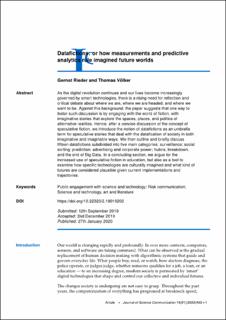Datafictions: Or how measurements and predictive analytics rule imagined future worlds
| dc.contributor.author | Rieder, Gernot | |
| dc.contributor.author | Völker, Thomas | |
| dc.date.accessioned | 2021-07-15T10:26:39Z | |
| dc.date.available | 2021-07-15T10:26:39Z | |
| dc.date.created | 2020-10-13T14:19:46Z | |
| dc.date.issued | 2020 | |
| dc.identifier.issn | 1824-2049 | |
| dc.identifier.uri | https://hdl.handle.net/11250/2764503 | |
| dc.description.abstract | As the digital revolution continues and our lives become increasingly governed by smart technologies, there is a rising need for reflection and critical debate about where we are, where we are headed, and where we want to be. Against this background, the paper suggests that one way to foster such discussion is by engaging with the world of fiction, with imaginative stories that explore the spaces, places, and politics of alternative realities. Hence, after a concise discussion of the concept of speculative fiction, we introduce the notion of datafictions as an umbrella term for speculative stories that deal with the datafication of society in both imaginative and imaginable ways. We then outline and briefly discuss fifteen datafictions subdivided into five main categories: surveillance; social sorting; prediction; advertising and corporate power; hubris, breakdown, and the end of Big Data. In a concluding section, we argue for the increased use of speculative fiction in education, but also as a tool to examine how specific technologies are culturally imagined and what kind of futures are considered plausible given current implementations and trajectories. | en_US |
| dc.language.iso | eng | en_US |
| dc.publisher | Sissa Medialab | en_US |
| dc.rights | Attribution-NonCommercial-NoDerivatives 4.0 Internasjonal | * |
| dc.rights.uri | http://creativecommons.org/licenses/by-nc-nd/4.0/deed.no | * |
| dc.title | Datafictions: Or how measurements and predictive analytics rule imagined future worlds | en_US |
| dc.type | Journal article | en_US |
| dc.type | Peer reviewed | en_US |
| dc.description.version | publishedVersion | en_US |
| dc.rights.holder | Copyright the authors | en_US |
| dc.source.articlenumber | A02 | en_US |
| cristin.ispublished | true | |
| cristin.fulltext | original | |
| cristin.qualitycode | 1 | |
| dc.identifier.doi | 10.22323/2.19010202 | |
| dc.identifier.cristin | 1839229 | |
| dc.source.journal | JCOM - Journal of Science Communication | en_US |
| dc.identifier.citation | JCOM - Journal of Science Communication. 2020, 19 (1), A02. | en_US |
| dc.source.volume | 19 | en_US |
| dc.source.issue | 1 | en_US |

